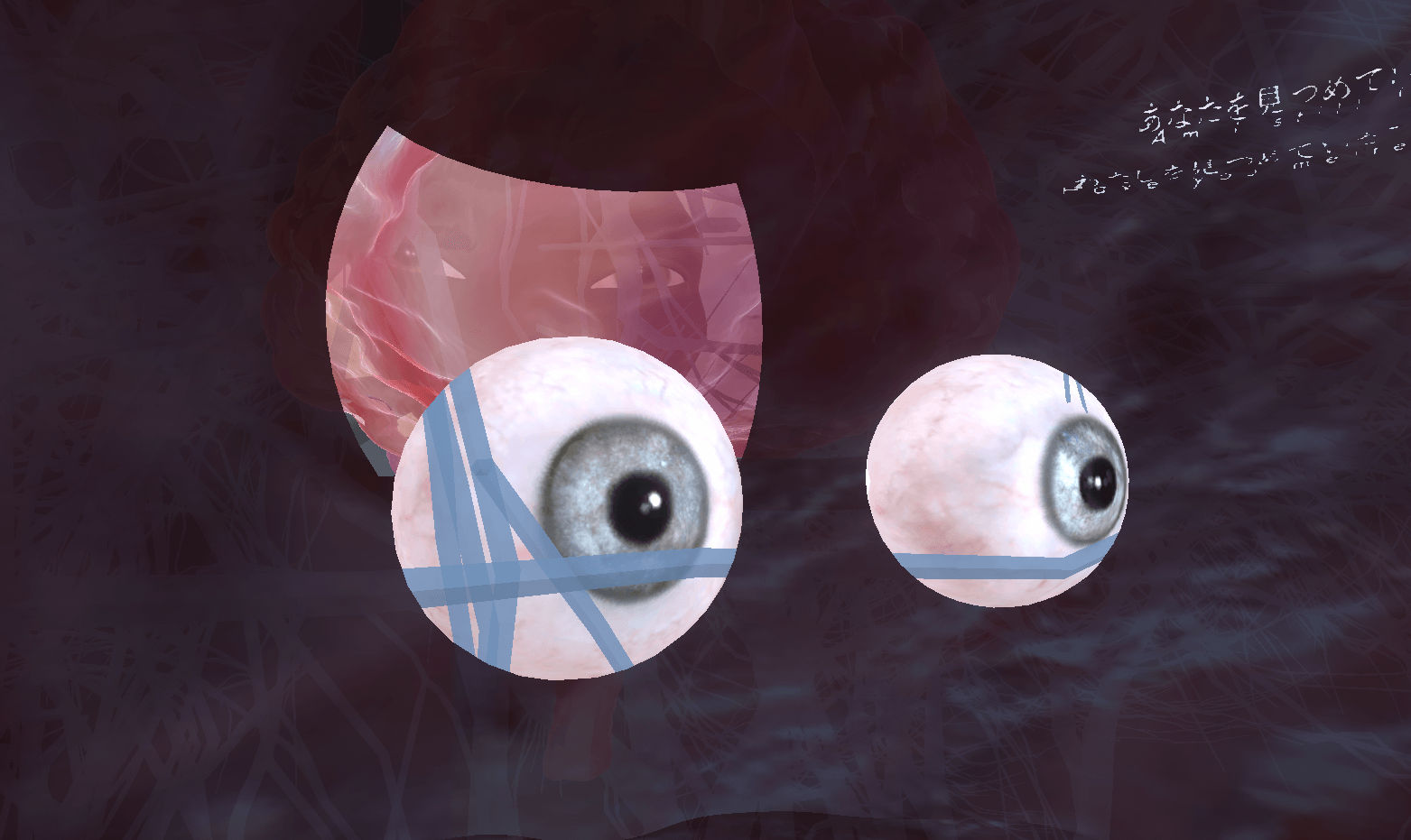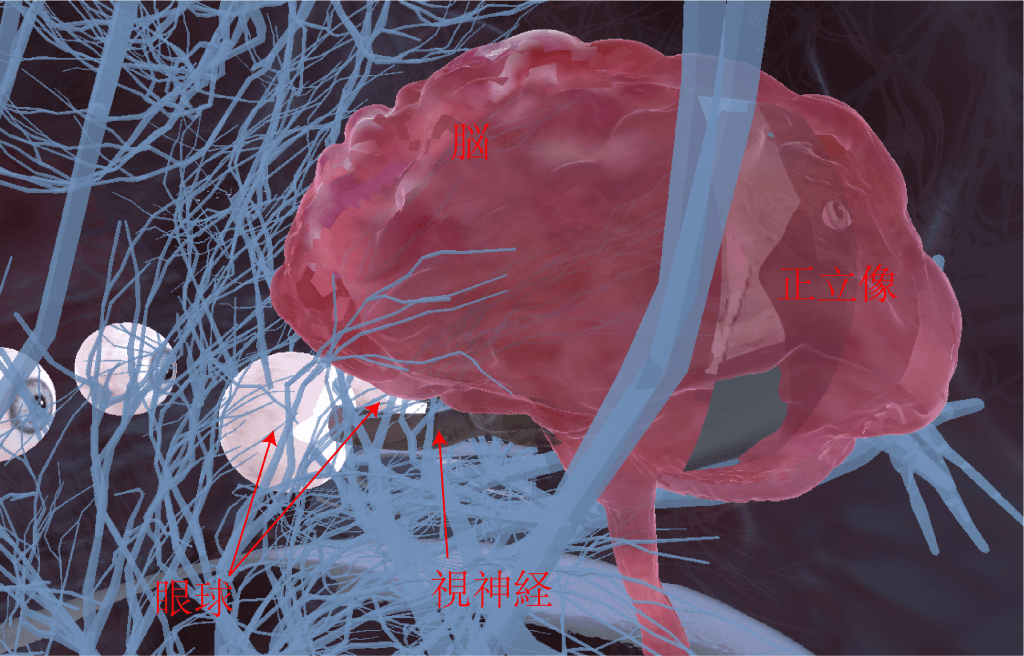この記事では、NEWVIEW AWARDS2020 SILVER PRIZEを受賞したVR作品「gaze on me」を紹介します。
gaze on meはドイツ在住のアーティスト「Miki Nigo」さんによって制作された作品です。
Miki Nigoさんは、NEWVIEW SCHOOLの学生インターンとして参加し、その年のNEWVIEW AWARDSに受賞される快挙を成し遂げました。
gaze on meのテーマでもある「視る」について読み取り、鑑賞のポイントを紹介します。

gaze on me
Miki Nigoさんについて
Miki Nigoさんはドイツ在住のアーティストで、3DCG/インスタレーションを中心に表現活動を行っています。STYLYとの出会いをきっかけに、XRの領域にも進出し、gaze on meはXRアートの初発表作品となります。
過去の3DCG作品としては、日本のエクスペリメンタル/インダストリアルミュージシャン「BROKEN HAZE」のMusic Videoを制作しました。
gaze on meではNEWVIEW AWARDS2020 SILVER PRIZEを受賞しました。
SILVER 3作品目はMiki Nigoさんの「gaze on me」です!#NEWVIEW2020https://t.co/K7nKL5IRHn
— NEWVIEW (@NEWVIEW_PROJECT) December 17, 2020
インスタレーション、3DCGの制作をベースに、アーティストとしてのXRの着眼点を用いて表現された作品として、今回「gaze on me」が制作されました。
人間の体内へ没入し、Mikiさんの思考する「視る」行為への問いかけが鑑賞者に向けられた作品となり、多くの人を魅了しました。
“gaze on me”について
この作品は「視る」行為についての構造と、私たちの感情について問いかけられる作品です。
シーンが始まると微笑みかける巨大な人間が眼前に現れます。

微笑みかける
視線の反対には同じように、微笑みかける巨大な人間がいます。お互いの頬に触れて。
カメラは自動で移動し、シーンが切り替わり、木々のように生い茂った「神経」のような物体、2つの眼球と脳みそ、そして「像」が空間内に現れます。

人の体内なのだろうか
空間内には一つの詩のようなメッセージが。
「あなたを見つめていた“わたし”は、まだ“わたし”なのだろうか?(Am I still I who was gazing at you?)」
「わたしを見つめていた“あなた”は、わたしと一緒に溶けてしまっただろうか?(Have you melted with me as you gazed at me?)」

メッセージ
そして、奥に進むと細胞のような空間に覆われた内臓のオブジェクトが配置されています。

内臓
オブジェクトとメッセージをベースに、この作品を鑑賞した際の特徴や興味深い点を紹介します。
科学へのアプローチ
私たちが眼を通して世界を「視る」ことができるのは、眼球と神経、そして脳の仕組みによって可能になっています。
大きな仕組みは以下の通りです。
人間の目に入ってきた光は,角膜の後ろの水晶体(レンズ)で曲げられ, ガラス体を通過して,眼球の奥の網膜上で像を結びます. 網膜にはたくさんの視細胞が並んでいて, 光によって刺激を受けると,それを信号として脳に伝えます. この視細胞から脳への情報の伝達を担っているのが視神経です.
網膜に映る像は,実際は倒立像なのですが, 脳がその情報を正立像へ変換して,それを私たちは認識しています.
(「目のしくみ」(望遠鏡と観測装置, 裳華房)より引用 https://www.shokabo.co.jp/sp_opt/observe/eye/eye.htm)
この作品はその仕組みを3DCGのモデルによって具象しています。
VRの作品は、現実をシミュレートする必要もなく自由に作れる中で科学の事実に基づいて現実を引用することは、私たちが生きる現実への問いかけの構造と読み取れます。
バーチャルはリアルに対するオルタナティブな空間であり、同時に現実へのアプローチ/カウンターとしても存在させることができます。
人間科学へアプローチし、3DCGの具象を通してMikiさんはバーチャルを使ってリアルへアプローチしているのではないでしょうか。
具象を踏まえて、リアルの何へアプローチしているのか、作品全体を通して読み取ります。
「視る」と「感情」
Mikiさんはこの作品の説明として以下のように提示します。
あなたはあなたの大切な人と見つめ合っている時、何を考えているだろう?
互いの像が互いの視神経を通じてそれぞれの脳へと届けられている瞬間、そこにどのような感情が宿るのだろうか。
この作品でプレーヤーは『至近距離で見つめあった人間同士に生じる気配』へ紛れ込む。
そして二人の”眼差し”として互いを巡り、存在を思考する。
(NEWVIEW AWARDS 2020 「gaze on me」のページより引用 https://newview.design/works/gaze-on-me/)
大切な人、それは友人、家族、恋人、仲間などが当てはまるのではないでしょうか。
私たちは大切な人と会ったとき、相手を見つめ、相手を認識します。その時私たちには感情が沸き上がってきます。
「好き」「嫌い」「愛している」「憎い」「心地よい」「不愉快」
Mikiさんの作品のポイントは、この感情と「視る」について観察することだと感じます。
感情は科学的に研究されていると同時に、言葉や科学で表すことができない領域も多く存在する現象ではないでしょうか。
視る、という科学的に解明されている行為に対して、未知な部分の感情の現象がどのように私たちの存在と認知を形成しているのか。その問いについて鑑賞しながら思考する空間となります。
「あなたを見つめていた“わたし”は、まだ“わたし”なのだろうか?(Am I still I who was gazing at you?)」
「わたしを見つめていた“あなた”は、わたしと一緒に溶けてしまっただろうか?(Have you melted with me as you gazed at me?)」
このメッセージの「溶ける」という現象は、「わたし」と「あなた」の存在の境界について問いかけてるのではないでしょうか。
「視る」と「感情」、2つの現象を通して観察することで、その境界の曖昧性や、科学的な観測を超えた人間の神秘性について思考できるのではないでしょうか。
上記はあくまで私が鑑賞した感想です。この作品はそれ以上に幅広く鑑賞できるポイントがあるのではいないでしょうか。
そのポイントを探しながら鑑賞してくことにも面白さがあると思います。
VRメディアとしての行為
最後に、VRを使って「体内にダイブする」行為についてレビューします。
この作品を鑑賞して気づいたのが、この作品はVRを使って「人間の体内にダイブする」行為を表現しています。その点にメディアとしての面白さを感じました。
VRが日本で普及し、発表された作品の多くはアニメ・ゲーム的な領域の「バーチャルワールド」的な体験や、建築ビジュアライゼーションなどが主流となっています。
しかし、この作品はバーチャルワールドでも、建築でもなく、「人間の体内」へアプローチした作品です。
このアプローチは、VRを描いてきたゲーム・漫画コンテンツの延長に位置するのでは、と感じました。
例えば、士郎正宗による漫画作品「攻殻機動隊」では、電脳と呼ばれる電子化された脳みそが登場します。その電脳を通してさまざまなサイバー事件が起き、ストーリーが展開していきます。
また、昨年発売されたゲーム「CYBERPUNK2077」では、VRの進化メディアとして「ブレインダンス」が登場します。これは、他者の記憶・体験、感情すべてをありのままに「体験する」ことができる装置です。
これら2つは、いわゆる「VR」としてのメディアがモニター的な体験を超えて、「脳科学」的なアプローチで体験できる装置として描写されています。
現在のVRでは、デバイスの性能上「疑似的な体験」が主流となっています。しかし、SF作品にあるように、もし他者の脳・体内へダイブすることができたら、作品自体の内容も大きく変わるのではないでしょうか。
Mikiさんの作品は、そんな未来を示唆しているように感じ取れます。
シーン
人間について思考する空間と体験をもたらす「gaze on me」。自分と他者を科学的な目線と、思考のプロセスの中でどのように認識しているのか、この空間に入ることで再認識することができるのではないでしょうか。
ぜひ体験してみましょう。
- スマートフォンから体験する STYLY Mobileをダウンロードし、シーンを立ち上げましょう。ダウンロードの方法は以下の記事を参考にしましょう。
- PC / VRからシーンを体験する
以下の画像をクリックするとSTYLY GALLERYのシーンのページへアクセスします。機器を選択し、体験しましょう。
未経験から VR/AR コンテンツ制作を学ぼう
VR/ARコンテンツ制作に必要なUnity・PlayMakerを基礎から応用まで学べ、STYLYで配信されている魅力的なコンテンツの制作過程(制作技術も公開します)を学べる オンライン学習サイト NEWVIEW SCHOOL ONLINE 開講中!!
- プログラミングコードをかかず、VR/ARコンテンツを制作可能
- 公式監修によるUnity講座を用意
- フォトグラメトリ制作方法、コンテンツ軽量化などの追加要素あり
- VR/ARコンテンツを作るための考え方を学習できる



